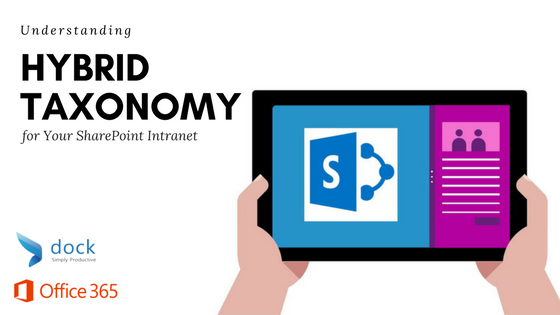
Let's dive right into this tutorial. To get started, launch the hybrid picker to choose hybrid taxonomy feature. The additional elements to include are input parameters, which are a Local Site URL. Provide a URL to a web application that consumes from the manage method into service application on premises.
Next, provide the Term Store Name that needs to be the manage method service application name that we want to update for the Office 365 Taxonomy store. Then provide Remote Group Names, which are optional parameters and the term sets to pull down from Office 365. The last step is validation that takes place to ensure that the data you entered is correct, check that the groups exist and the site exists.
Deployment Steps:
- Deployment method is via Hybrid Picker
- Launch Hybrid Picker from Office 365 (SharePoint Online Hybrid Settings Page)
- Choose Hybrid Taxonomy feature
- Supply Input parameters
- Input taxonomy parameters
- Local site URL
- Local term storm names
- Remote group names (optional)
- Validate the input
Now, once the actual features have been deployed, the next step is to have a small piece of configuration to control how the feature operates.
Manage Replication:
- To modify the list of replicated groups, rerun the Hybrid Wizard
- To modify the Taxonomy Groups Replication schedule, edit the Timer Job properties
- To disable Taxonomy Groups replication, either disable the Timer Job in the User Interface or use Stop-SPTaxonomyReplication
Generally, when you’re performing the initial implementation of the hybrid feature, here are some optional configuration aspects. To get your existing corporate taxonomy that you’ve already built up over several years on-premises and move that into the cloud, so that you can use this implementation in the cloud or in Office 365 as a master source for all the changes.
Optionally copy on premises Taxonomy to Office 365
- Remove or replace AD Groups on term groups
- AD Groups aren’t copied
- Replace with individual accounts or
- Add Azure AD Groups post copy
- Use Copy-SPTaxonomyGroups PowerShell to copy the required groups from on premises to Office 365.
Now we can deploy and configure the Hybrid Taxonomy features by navigating to your Office365 Administration Center. The Taxonomy feature is going to be a hybrid feature for SharePoint servers on-premises and online. Once you’ve navigated to the SharePoint administration page, click on configure hybrid and launch the hybrid picker, which downloads the page and then click on Launch. This will download, install the Picker and then execute it to configure a hybrid scenario for you.
Then click the Next button to provide credentials. The first set of credentials or account that has the full file administration rights to configure the farm to support the hybrid configuration. The second set of credentials must be tenant administration credentials, enabling you to make configuration changes to the tenancy to support a hybrid scenario. Once you’ve entered them, validate those credentials to ensure that the accounts you’ve provided have access to the appropriate services to make the needed changes. Click the Close button and then Next.
The Picker will now validate that this local SharePoint server farm is configured appropriately. To support they hybrid scenario, click Next. Then choose the individual hybrid scenario that you want to deploy. You’ll have the option to supply additional parameters depending on what you’re setting up. In this case, you’ll want to deploy the hybrid taxonomy scenario. Provide the local site URL. You need a reference on the local SharePoint server farm to connect to the managed metadata service. Then provide the local term store name and then you have options to do, things like deciding what remote groups to configure or replicate or to stick with all. Then validate, this confirms that the well application is correct, then click OK and then click Next.
What will happen now is the Picker will run through a series of PowerShell commands configuring and deploying the Hybrid Replication feature. Most significantly is how it will create a new timer job that will be sued to replicate the taxonomy from Office 365 down into SharePoint on-premises. Then click Next and provide feedback and click Close. That deploys the actual feature. To see the feature in action, go back to the SharePoint administration page and look at your term store, you will see that there are terms inside this terms store that we want to replicate down. It was set up to replicate everything. The ones that you’re interested in here is the deployed a custom term set called demo set, under Microsoft Virtual Academy.
In this example, we’re using a hybrid demo and office demo terms. We want to see this term set appear in the on-premises Managed Metadata service application. Now the timer job that’s deployed onto the local farm is configured to run daily, look at the timer job, by definitions, scroll down to the next page. You’ll see there’s a timer job called Taxonomy Groups Replication. This timer job is already configured to run daily. You can modify the configuration to replicate taxonomy more frequently as well. Test it by clicking Run Now, which will execute the timer job, perform the replication and it’s complete.
Return to the Managed Metadata Service application on-premises. Manage to your navigation to Managed Service applications, click on Managed Metadata Service. Look for the same taxonomy term set that you saw in Office 365. Once you’ve made sure the term set is there, the timer job will take care of making changes to this term set if changes are made in Office 365. When that timer job runs, they’ll be replicated down into the on-premises Term Store.
Book a Live demo
Schedule a live demo of Dock 365's Contract Management Software now.
Written by Jessica Northey
She's a multimedia producer to include writing, photography, graphic design and video. She enjoys learning about new technology for business and exploring her city in Jacksonville, Florida.





